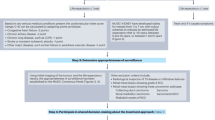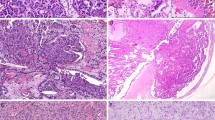Abstract
The incidence of renal cell carcinoma is increasing, in part due to the growing use of cross-sectional imaging. Most renal tumors are now incidentally detected as small masses in asymptomatic patients. A minority of small renal masses, presumed to be renal cell carcinoma, grow significantly over time if managed conservatively, but the growth rate of the majority is slow or undetectable. In the absence of other prognostic factors, measurement of tumor growth rate can be helpful for initial conservative management of selected patients with small renal tumors. To date, there have been no reports of progression to metastatic disease occurring during active surveillance, but longer follow-up is needed to confirm this observation. The standard of care for small localized renal neoplasms is partial or radical nephrectomy. At the present time, active surveillance of small renal masses, with delayed therapy for patients whose disease progresses, is an experimental approach that can be considered for the elderly or patients with significant comorbidity. Renal core biopsy and fine-needle aspiration can provide essential information for treatment decision-making and should therefore be considered in the diagnostic work-up of all small renal masses. In future, the identification of prognostic indicators, with the use of new techniques including functional imaging and molecular or genomic characterization of tissue from needle biopsies, are expected to help clinicians differentiate between indolent and potentially aggressive small renal tumors.
This is a preview of subscription content, access via your institution
Access options
Subscribe to this journal
Receive 12 print issues and online access
$209.00 per year
only $17.42 per issue
Buy this article
- Purchase on Springer Link
- Instant access to full article PDF
Prices may be subject to local taxes which are calculated during checkout
Similar content being viewed by others
References
Ries LA et al. (2005) SEER Cancer Statistics Review, 1975–2002. National Cancer Institute: Bethesda, MD
Pantuck AJ et al. (2001) The changing natural history of renal cell carcinoma. J Urol 166: 1611–1623
Chow WH et al. (1999) Rising incidence of renal cell cancer in the United States. JAMA 281: 1628–1631
Hock LM et al. (2002) Increasing incidence of all stages of kidney cancer in the last 2 decades in the United States: an analysis of surveillance, epidemiology and end results program data. J Urol 167: 57–60
Tsui KH et al. (2000) Renal cell carcinoma: prognostic significance of incidentally detected tumors. J Urol 163: 426–430
Skinner DG et al. (1971) Diagnosis and management of renal cell carcinoma. A clinical and pathologic study of 309 cases. Cancer 28: 1165–1177
Luciani LG et al. (2000) Incidental renal cell carcinoma—age and stage characterization and clinical implications: study of 1092 patients (1982–1997). Urology 56: 58–62
Jayson M and Sanders H (1998) Increased incidence of serendipitously discovered renal cell carcinoma. Urology 51: 203–205
Lee CT et al. (2000) Surgical management of renal tumors 4cm or less in a contemporary cohort. J Urol 163: 730–736
Licht MR et al. (1994) Nephron sparing surgery in incidental versus suspected renal cell carcinoma. J Urol 152: 39–42
Patard JJ et al. (2002) Prognostic significance of the mode of detection in renal tumours. BJU Int 90: 358–363
Thompson IM and Peek M (1988) Improvement in survival of patients with renal cell carcinoma—the role of the serendipitously detected tumor. J Urol 140: 487–490
Katz DL et al. (1994) Time trends in the incidence of renal carcinoma: analysis of Connecticut Tumor Registry data, 1935–1989. Int J Cancer 58: 57–63
Sweeney JP et al. (1996) Incidentally detected renal cell carcinoma: pathological features, survival trends and implications for treatment. Br J Urol 78: 351–353
Frank I et al. (2003) Solid renal tumors: an analysis of pathological features related to tumor size. J Urol 170: 2217–2220
Dechet CB et al. (1999) Prospective analysis of intraoperative frozen needle biopsy of solid renal masses in adults. J Urol 162: 1282–1285
Bretheau D et al. (1995) Prognostic significance of incidental renal cell carcinoma. Eur Urol 27: 319–323
Bell ET (1950) In Renal disease. Philadelphia: Lea and Febiger
Bosniak MA et al. (1995) Small renal parenchymal neoplasms: further observations on growth. Radiology 197: 589–597
Oda T et al. (2001) Growth rates of primary and metastatic lesions of renal cell carcinoma. Int J Urol 8: 473–437
Rendon RA et al. (2000) The natural history of small renal masses. J Urol 164: 1143–1147
Volpe A et al. (2004) The natural history of incidentally detected small renal masses. Cancer 100: 738–745
Kassouf W et al. (2004) Natural history of renal masses followed expectantly. J Urol 171: 111–113
Wehle MJ et al. (2004) Conservative management of incidental contrast-enhancing renal masses as safe alternative to invasive therapy. Urology 64: 49–52
Kato M et al. (2004) Natural history of small renal cell carcinoma: evaluation of growth rate, histological grade, cell proliferation and apoptosis. J Urol 172: 863–866
Lamb GW et al. (2004) Management of renal masses in patients medically unsuitable for nephrectomy—natural history, complications, and outcome. Urology 64: 909–913
Kohanim S et al. (2005) Small (less than 1.5 cm) renal tumor with confirmed lung metastases. Urology 65: 172–173
Parsons JK et al. (2001) Incidental renal tumors: casting doubt on the efficacy of early intervention. Urology 57: 1013–1015
Wunderlich H et al. (1998) Increase of renal cell carcinoma incidence in central Europe. Eur Urol 33: 538–541
Hellsten S et al. (1990) Clinically unrecognized renal cell carcinoma. Diagnostic and pathological aspects. Eur Urol 18 Suppl 2: 2–3
Gillett MD et al. (2005) Comparison of presentation and outcome for patients 18 to 40 and 60 to 70 years old with solid renal masses. J Urol 173: 1893–1896
Yaycioglu O et al. (2002) Clinical and pathologic tumor size in renal cell carcinoma. difference, correlation, and analysis of the influencing factors. Urology 60: 33–38
Punnen S et al. (2004) Variability in size measurements of small renal masses on CT imaging. J Urol 171: 507
Onishi T et al. (2001) Cyst-associated renal cell carcinoma: clinicopathologic characteristics and evaluation of prognosis in 27 cases. Int J Urol 8: 268–274
Corica FA et al. (1999) Cystic renal cell carcinoma is cured by resection: a study of 24 cases with long-term followup. J Urol 161: 408–411
Lechevallier E et al. (2000) Fine-needle percutaneous biopsy of renal masses with helical CT guidance. Radiology 216: 506–510
Wood BJ et al. (1999) Imaging guided biopsy of renal masses: indications, accuracy and impact on clinical management. J Urol 161: 1470–1474
Neuzillet Y et al. (2004) Accuracy and clinical role of fine needle percutaneous biopsy with computerized tomography guidance of small (less than 4.0 cm) renal masses. J Urol 171: 1802–1805
Herts BR and Baker ME (1995) The current role of percutaneous biopsy in the evaluation of renal masses. Semin Urol Oncol 13: 254–261
Pantuck AJ et al. (2000) Incidental renal tumors. Urology 56: 190–196
Reddan DN et al. (2001) Management of small renal tumors: an overview. Am J Med 110: 558–562
Fergany AF et al. (2000) Long-term results of nephron sparing surgery for localized renal cell carcinoma: 10-year followup. J Urol 163: 442–445
Gill IS et al. (2003) Comparative analysis of laparoscopic versus open partial nephrectomy for renal tumors in 200 patients. J Urol 170: 64–68
Link RE et al. (2005) Exploring the learning curve, pathological outcomes and perioperative morbidity of laparoscopic partial nephrectomy performed for renal mass. J Urol 173: 1690–1694
Mejean A et al. (1999) Mortality and morbidity after nephrectomy for renal cell carcinoma using a transperitoneal anterior subcostal incision. Eur Urol 36: 298–302
Uzzo RG and Novick AC (2001) Nephron sparing surgery for renal tumors: indications, techniques and outcomes. J Urol 166: 6–18
Stephenson AJ et al. (2004) Complications of radical and partial nephrectomy in a large contemporary cohort. J Urol 171: 130–134
Rendon RA et al. (2002) The uncertainty of radio frequency treatment of renal cell carcinoma: findings at immediate and delayed nephrectomy. J Urol 167: 1587–1592
Desai MM and Gill IS (2002) Current status of cryoablation and radiofrequency ablation in the management of renal tumors. Curr Opin Urol 12: 387–393
Luciani LG (2001) Re: Renal cell carcinoma: prognostic significance of incidentally detected tumors. J Urol 165: 1223
Frank I et al. (2002) An outcome prediction model for patients with clear cell renal cell carcinoma treated with radical nephrectomy based on tumor stage, size, grade and necrosis: the SSIGN score. J Urol 168: 2395–2400
Zisman A et al. (2001) Re-evaluation of the 1997 TNM classification for renal cell carcinoma: T1 and T2 cutoff point at 4.5 rather than 7 cm better correlates with clinical outcome. J Urol 166: 54–58
Walther MM et al. (1999) Renal cancer in families with hereditary renal cancer: prospective analysis of a tumor size threshold for renal parenchymal sparing surgery. J Urol 161: 1475–1479
Gelb AB et al. (1997) Appraisal of intratumoral microvessel density, MIB-1 score, DNA content, and p53 protein expression as prognostic indicators in patients with locally confined renal cell carcinoma. Cancer 80: 1768–1775
Takahashi M et al. (2001) Gene expression profiling of clear cell renal cell carcinoma: gene identification and prognostic classification. Proc Natl Acad Sci U S A 98: 9754–9759
Takahashi M et al. (2003) Molecular subclassification of kidney tumors and the discovery of new diagnostic markers. Oncogene 22: 6810–6818
Young AN et al. (2001) Expression profiling of renal epithelial neoplasms: a method for tumor classification and discovery of diagnostic molecular markers. Am J Pathol 158: 1639–1651
Author information
Authors and Affiliations
Corresponding author
Ethics declarations
Competing interests
The authors declare no competing financial interests.
Rights and permissions
About this article
Cite this article
Volpe, A., Jewett, M. The natural history of small renal masses. Nat Rev Urol 2, 384–390 (2005). https://doi.org/10.1038/ncpuro0254
Received:
Accepted:
Issue Date:
DOI: https://doi.org/10.1038/ncpuro0254
This article is cited by
-
Small renal masses in Latin-American population: characteristics and prognostic factors for survival, recurrence and metastasis – a multi-institutional study from LARCG database
BMC Urology (2020)
-
Hypoxia-inducible factor (HIF)-independent expression mechanism and novel function of HIF prolyl hydroxylase-3 in renal cell carcinoma
Journal of Cancer Research and Clinical Oncology (2014)
-
Volume doubling time and growth rate of renal cell carcinoma determined by helical CT: a single-institution experience
European Radiology (2008)
-
Diagnostic utility of S100A1 expression in renal cell neoplasms: an immunohistochemical and quantitative RT-PCR study
Modern Pathology (2007)



